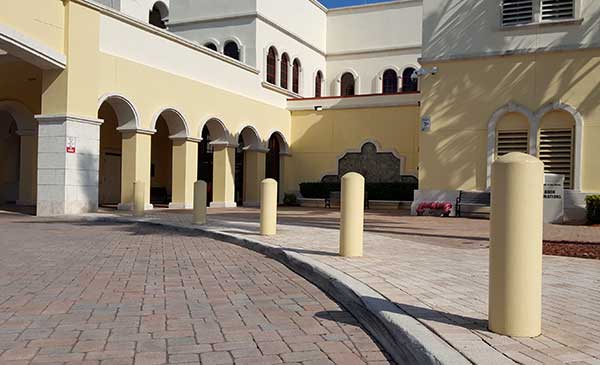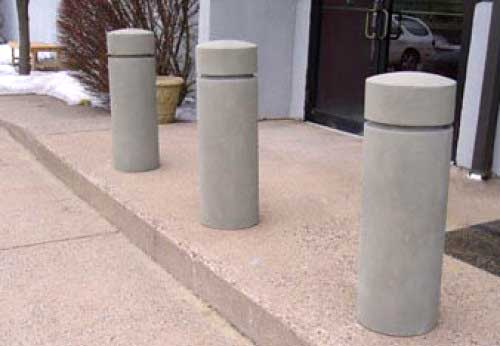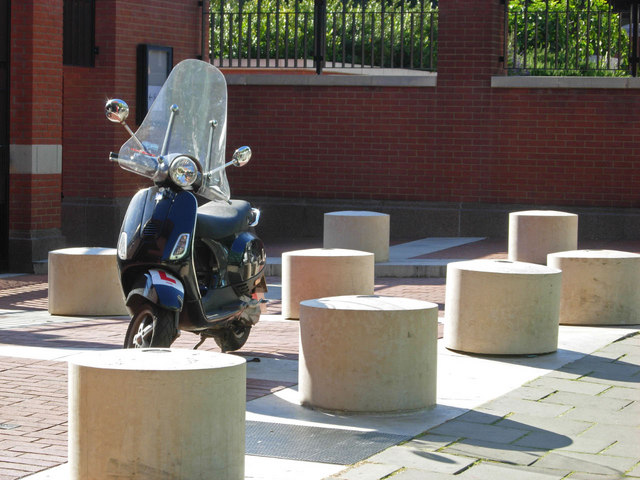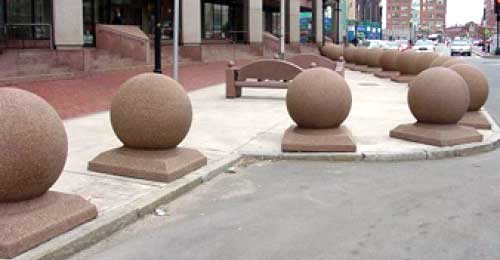 Concrete bollards protecting a sidewalk. Notice how the cement is painted the same color as the building, another option available with concrete bollards
Concrete bollards protecting a sidewalk. Notice how the cement is painted the same color as the building, another option available with concrete bollards
By Gerald Dlubala
Bollards as protective devices have been used going back to the late 1700s, when the first ones were crafted using everything from heavy tree trunks to old, vertically planted cannon barrels to the modern concrete bollards used today.
As they have become more sophisticated, modernized, and more skillfully manufactured, concrete bollards are now more personalized and aesthetically appealing.
And even though bollards are used as barriers to keep pedestrians safe from vehicular traffic, they have become just as important in keeping motor vehicles out of specific areas of concern, whether enclosing pedestrian traffic or not.
The popularity of concrete bollards increased in the 1990s when they began to be the preferred choice for protecting campuses and other highly populated buildings.
Credit the world of vehicle-based terrorism for that. Concrete or cement bollards started popping up in front of every location that was deemed vulnerable or a security risk.
In the US, that at-risk category contained more than 90,000 sites, buildings, campuses, districts and structures that could all be considered candidates for the use of security bollards.
Bollards have come a long way since then, transforming from bulky eyesores to the more aesthetically pleasing, visually-appealing structures that are available today. They are used for such things as the prevention of pedestrian and vehicle interaction, the altering of traffic patterns, and much more.
Concrete bollards designed with landscape compatibility in mind
Concrete and cement bollards (cement is actually one of the materials in concrete) have become a natural part of landscape design, but now they can be made to complement the landscape rather than something that needs to be hidden.
In fact, with customization options like color and finish, new concrete bollards can be installed as the architectural centerpiece of your project. With creative shapes and designs, bollards are available to match any environment in which you need them. Available shapes and forms include:
- Round/Cylindrical. Perhaps the most recognized are concrete ball bollards, cylindrical and positioned upright, with either a surface or in-ground mount, depending on the amount of resistance needed. Available in various diameters and heights.
 Concrete bollards protect a glass doorway
Concrete bollards protect a glass doorway - Angled edges, able to be positioned as squares or diamond shape, short and wide, up to taller and more slender.
- Sleek/Tapered look, for a more striking and modern appearance. Whether it's a wide base tapering to a smaller diameter top or different textures and widths along the length of the bollard, each different design adds a level of depth to your landscape.
- Decorative/Architectural/Novelty. Concrete bollards can range from spherical, bowling ball shapes to three-dimensional replicas, including themed designs that will give an appearance of an architectural addition rather than a cement security barrier. The concrete bollards serve double duty as beautification structures while stopping accessibility to motor vehicles, ultimately protecting pedestrian traffic.
- Lighted bollards can also serve as subtle night lighting, illuminating paths and providing direction on greenways with lighting features built right into the bollard. Lighted bollards are also used to point out restrictions along walkways and as borders for streets and pedestrian pathways.
- Customized and accessorized. Concrete bollards are maintenance-free, offering finishes including the natural concrete, various stain colors, thermoplastic coatings, colored covers and recycled glass that is incorporated into the cement of the bollard.
Cement bollard use on the rise
 Parking bollards delineate areas where cars can and cannot park
Parking bollards delineate areas where cars can and cannot park
Uses of concrete bollards are on the increase because of the versatility that they bring with them. Popular and useful ways that bollards can be used include:
- As a pedestrian barrier for areas that have heavy foot traffic. Bollards automatically increase the walkability of areas by providing safety and security against motor vehicle interactions. With a secure walking path, pedestrians can safely get around without the fear of not being seen by motor vehicle drivers.
- To protect cycling traffic. Concrete bollards can be installed as a safe and secure way to separate bike lanes and bicycle parking racks from motor traffic on streets where no separate bike path is available, especially within or around intersections and merging traffic lanes.
- Around educational and business campuses. Installed at the beginning of interconnecting walkways and paths between buildings and areas of the campus, pedestrian bollards are the perfect way to designate walkways, pathways and greenways as people-only areas.
- Protecting drivers on roadways designated as high-risk areas, including the shoulders of roads including curves, blind hills, and zigzag type roads with drop-offs. Injuries and deaths caused by vehicles leaving the road may be lessened by installing high impact concrete bollards on the sides of these roads, including automobiles driving up on pedestrian used sidewalks.
- Outside military or government buildings or complexes, or domestic areas in need of high-security environments. With the surge in vehicles used in terrorist-type violence, reducing the chance of the vehicles being able to get close to the buildings in question is imperative. Concrete bollards will make sure to stop the vehicle before it can make it to the populated areas, ensuring that the buildings are secure, and the inhabitants stay safe.
- Traffic management. Emergencies or other road closures will cause disruptions, changing the normal commuting paths, whether walking or driving. Bollards are useful in steering vehicular and people traffic where you want them to go, keeping them on the safest path.
- Path and greenway illumination. Pedestrians and cyclists will stay on track and separated from motor vehicle hazards by being able to follow a path or greenway lined with lighted bollards.
- Beautify your landscape while simultaneously increasing security. Double the value of your landscape and security budgets by installing bollards that double as architectural accents. Novelty designs or specialized structures will perform their function while also enhancing the appearance of the area.
- Parking bollards. Bollards can be used to prevent cars from entering or exiting lots in the wrong spots, decreasing the chances of dangerous interaction with pedestrians. Additionally, with properly placed parking bollards, cars will not be able to stop on sidewalks or other walking areas, reducing chances of injury.
- Protection for street level seating for restaurants, bars and other venues that want to make sure their patrons are protected while enjoying time outdoors on their patios and street level tables.
- Bike parking areas. Using concrete bollards to outline a designated area for bike parking racks guarantees separate spaces for bicycles and cars. With bike accidents on the rise in some heavily populated areas, the more you can separate the two modes of transportation, the better off both parties will be.
Through a large variety of choices in size, shape, and color, bollards can effectively protect any areas from motor vehicle intrusion, including extreme activities like terrorism and distracted driving.
And you can do it while increasing the aesthetics of your landscape.
By taking the initiative and installing concrete bollards or cement bollards, manufactured and installed to meet the resistance specifications and crash ratings that you need, you can protect pedestrians, buildings and fragile historical monuments from damage due to dangerous and out of control motor vehicles.
 Concrete sphere bollards are often used for security in front of government buildings
Concrete sphere bollards are often used for security in front of government buildings


